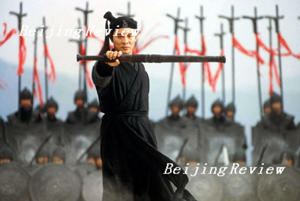
“Finally we turned losses into gains! Now I don’t have to be sorry for this century-old cinema,” Wang Zhanyou said with a sigh of relief.
Wang, the 12th manager in the long history of Beijing’s Daguanlou Cinema, decided to temporarily close the historic building in June for a thorough renovation. The facelift was partly intended for the centennial celebration of Chinese movies, but also to encourage recent box office success.
Under Wang’s management, the cinema had begun to make a profit again, drawing the crowds that had long disappeared.
Daguanlou Cinema, which means “Grand Shadow Play,” has a history as long as Chinese cinema itself. It opened in 1903 and was renovated to show movies in 1906. The cinema’s first manager, Ren Qingtai, was a cutting-edge photographer who studied in Japan and invested in the production of China’s first movie, Conquering Jun Mountain.
Ren had the sensibility of an artist as well as an entrepreneur. He found that 10 years after being introduced, foreign short films had lost their original attraction to Chinese audiences. He turned his eyes to Beijing opera, the most popular art form at the time, and invited Tan Xinpei, then known as the “King of Beijing Opera,” to perform in Conquering Jun Mountain. It proved to be a great success.
Different from the films of the Lumière brothers, which featured scenes from daily life, early Chinese movies involved traditional art. Later, incorporating traditional culture into contemporary movies became common practice for many Chinese filmmakers.
Cinema’s Teenage Years
Unfortunately, a big fire destroyed the film stock for Conquering Jun Mountain in 1909. Around this time, China began to be recognized as the world’s largest cinema market, with its 400 million population.
In Shanghai, American-Russian businessman Benjamin Brodsky established Asia Film Co., China’s first film company. With the capital and facilities provided by Asia Film Co., Zhang Shichuan and Zheng Zhengqiu, two figureheads in early Chinese cinema, directed The Difficult Couple in 1913. It is considered the first Chinese fiction film.
At the time, women were not allowed to star alongside men in plays and movies. But less than one year later, Yan Shanshan turned China’s arts community upside down by performing in a male-dominated film, playing the role of a maid in the Hong Kong movie Chuang-tzu Tests His Wife. Brodsky later took this film to the United States, making it the first Chinese movie played in a foreign country.
In 1923, after 10 years of development, Chinese cinema still had not found its own niche. Most movies followed a Western style, and how to better engage Chinese audiences became a common problem for people working in the industry.
| 